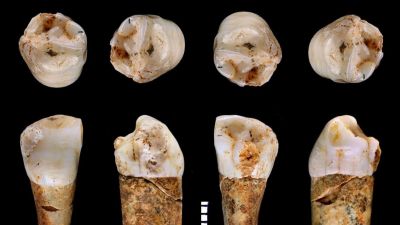University of Southampton study shows hunting habits and diets of Neanderthals living in Europe

A study by an international team of researchers, led by the University of Southampton, has given an intriguing glimpse of the hunting habits and diets of Neanderthals and other humans living in western Europe.
The scientists examined chemical properties locked inside tooth enamel to piece together how pre-historic people lived off the land around the Almonda Cave system, near Torres Novas in central Portugal almost 100 thousand years ago.
Their findings, published in the journal PNAS, show Neanderthals in the region were hunting fairly large animals across wide tracts of land, whereas humans living in the same location tens of thousands of years later survived on smaller creatures in an area half the size.
Samples were taken from two Neanderthals, dating back about 95,000 years, and from a more recent human who lived about 13,000 years ago, during the Magdalenian period.
The team showed that the Neanderthals, who were targeting large animals, could have hunted wild goat in the summer, whereas horses, red deer and an extinct form of rhinoceros were available all year round within about 30km of the cave. The Magdalenian individual showed a different pattern of subsistence, with seasonal movement of about 20km from the Almonda caves to the banks of the Tagus River, and a diet which included rabbits, red deer, wild goat and freshwater fish.
The researchers approximated the territory of the two different human groups, revealing contrasting results. The Neanderthals obtained their food over approximately 600 km2, whereas the Magdalenian individuals occupied a much smaller territory of about 300 km2.
Lead author, Dr Bethan Linscott who conducted the research while at the University of Southampton and who now works at the University of Oxford said: "Tooth enamel forms incrementally, and so represents a time series that records the geological origin of the food an individual ate.
"Using laser ablation, we can measure the variation of strontium isotopes over the two or three years it takes for the enamel to form. By comparing the strontium isotopes in the teeth with sediments collected at different locations in the region, we were able to map the movements of the Neanderthals and the Magdalenian individual. The geology around the Almonda caves is highly variable, making it possible to spot movement of just a few kms."
Co-author, Professor Alistair Pike of the University of Southampton, who supervised the research said: "This study shows just how much science has changed our understanding of archaeology in the past decade. Previously, the lives and behaviours of past individuals was limited to what we could infer from marks on their bones or the artefacts they used. Now, using the chemistry of bones and teeth, we can begin to reconstruct individual life histories, even as far back as the Neanderthals."
Co-author, Professor João Zilhão of the University of Lisbon, who led the excavation of the Almonda caves said: "The difference in the territory size between the Neanderthal and Magdalenian individuals is probably related to population density. With a relatively low population, Neanderthals were free to roam further to target large prey species, such as horses, without encountering rival groups. By the Magdalenian period, an increase in population density reduced available territory, and human groups had moved down the food chain to occupy smaller territories, hunting mostly rabbits and catching fish on a seasonal basis."
Want a quick and expert briefing on the biggest news stories? Listen to our latest podcasts to find out What You Need To Know...